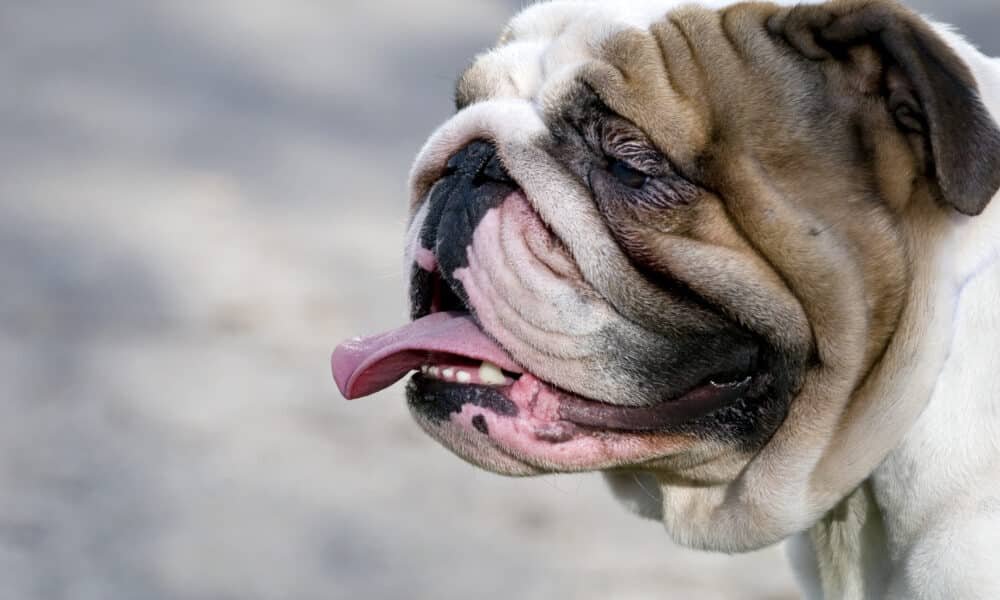A baby-face, prominent eyes, and a charm like no other – flat-faced dogs are becoming increasingly popular as family companions around the world.
And the U.S’ most popular dog breed for the past two years being a flat-faced dog breed, aka the French Bulldog, tells you everything you need to know about these dogs’ popularity.
However, despite their overwhelming popularity, awareness regarding the health issues that these flat-faced dog breeds are predisposed to don’t get as much attention.
So, to help dog owners understand these problems and help improve the welfare of these dog breeds, we’ll take a closer look and discuss the health issues that flat-faced dog breeds can suffer from.
What Are Flat-Faced Dog Breeds?
Flat-faced dog breeds, as the name suggests, are dog breeds that have a flat face or a short nose. Vets refer to these breeds as “brachycephalic”, a term derived from two Greek words ‘brakhu’ (short) and ‘cephalos’ (head), which translates to “short head”.


The most prominent features of flat-faced dog breeds include:
- A flattened muzzle: A flat-faced dog’s muzzle looks like it has been smushed or flattened inwards.
- Narrow or small nostrils: Due to their muzzle, a flat-faced dog’s nostrils are small and narrow, which often cause breathing problems.
- Disproportionately large head: A flat-faced dog’s head is large as a result of the skull shape being compressed on the front size. The face or muzzle widens, and therefore making the head appear larger. Furthermore, this also results in their bottom jaw being longer than their upper jaw.
- Prominent and bulging eyes: Again, this is a result of the structure of their skull that compresses their facial features.
- Skin folds: The skin folds around a flat-faced dog’s muzzle is also a result of their skull structure that compresses their facial features. While the muzzle is reduced as compared to other dogs, the skin around the area doesn’t reduce proportionately.
Here are dog breeds that are considered flat-faced:
- French Bulldog
- Pug
- Shih Tzu
- Pekingese
- Boxer
- Boston Terrier
- English Bulldog
- Chow Chow
- Bullmastiff
Historical Background Of Flat-Faced Dogs
The origins and historical background of flat-faced dogs can be traced back to ancient civilizations. For example, Pugs, who are believed to have originated in China in 400 B.C., were bred as companion animals for wealthy people.
Although before being the lovable and loyal companions that they are today, other flat-faced dogs, like the Bulldog, were selectively bred to fight in sports such as bullbaiting.
However, as society evolved, some of the roles of these dogs shifted from working/sporting animals to family companions.
And through this transition, the emphasis on these dogs’ physical appearance rather their functionality increased. Hence, the current and growing popularity of these breeds today.
Breeding Practices Of Flat-Faced Dogs


For thousands of years, humans have been selectively breeding dogs to have certain characteristics. Most of the time, these characteristics serve a function – hunting, herding, intelligence, temperament, athleticism, and many more.
Other times, humans selectively breed dogs for pure aesthetics. And in the case of flat-faced dog breeds, it’s both. As a matter of fact, a study published in PLOS One suggests this.
The study has two theories on why humans selectively breed flat-faced dogs
1. Functionality
Certain flat-faced dog breeds like the Bulldog were selectively bred to develop a flattened muzzle. It was believed that a shorter snout created stronger jaws that these dogs can use to their advantage during bullbaiting.
2. Aesthetic
The other theory is that dog owners back in ancient times loved the “cuteness” of these small dogs because they are able to retain infant-like features into adulthood. Features such as ‘puppy dog eyes’, round skulls, small noses, and short and plumb limbs reminded people of human infants.
And naturally, people find babies cute, so breeding dogs that have similar traits is purely for aesthetic purposes.
The Impact Of Flat-Faced Dog Breeding
Over time, breeders, especially those looking to make money off the most appealing dog breeds, started breeding dogs for the flattest faces and the biggest eyes, without any regard for the dog’s health.
And in addition to this, kennel clubs further reinforced these characteristics by establishing breed standards, making them a dog’s defining traits.
Unfortunately, these selective breeding practices doesn’t only breed “cute” dogs but also health problems.
Common Health Issues In Flat-Faced Dog Breeds
As dog owners, it is in our best interest to ensure that our four-legged friends live a long and healthy life. But sadly, this cannot be the same for flat-faced dog breeds.
As a matter of fact, a recent study from the Royal Veterinary College (RVC) reveals that flat-faced dogs are less healthy than other dogs.
So, if you own or planning to buy/adopt a flat-faced dog, it’s important that you are aware and knowledgeable of the following common health issues that they can experience in their life:
1. Breathing Problems


The most common problems in flat-faced dog breeds is a health issue called, Brachycephalic obstructive airway syndrome (BOAS). This is also called brachycephalic syndrome because it is common in brachycephalic or flat-faced dogs. And it refers to a set of upper airway abnormalities that makes breathing difficult, including:

